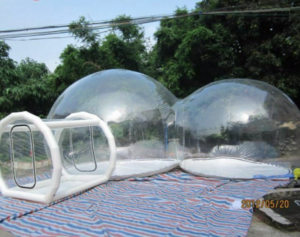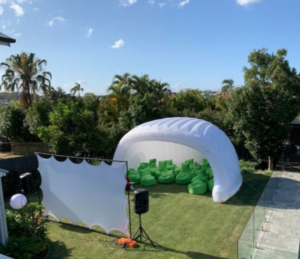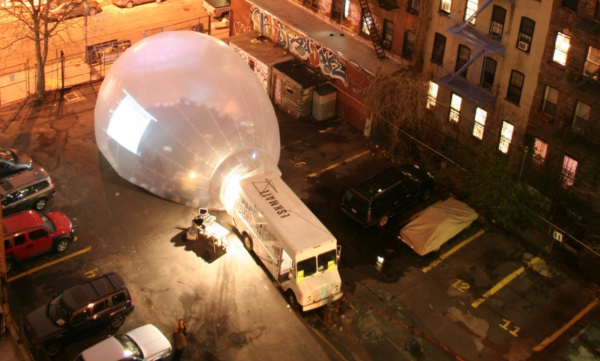Proposed for 2020, this community outreach project will design a resilience program with online education resources tailored for use during bushfires and COVID-19 outbreaks. It comprises design and implementation strategies for the use of a mobile dome fitted with air scrubber technology that will provide optimum air conditions free from smoke and COVID-19 when used in conjunction with other best practices. The project is unique in that it is devising novel overall designs and processes for mobile shared pop-up spaces as part of renewed interest in vernacular architecture: design approached as a place-based, life-giving process. Or, ‘design seen through a much needed decolonial, post-capitalist and feminist lens‘.(1)
A series of face-to-face and online community workshops led by Professor Richard Banati from Sydney University and the Australian Nuclear Science and Technology Organisation (ANSTO) will draw from his successful DFAT-funded community and student clean drinking water program hackathons with Sri Lankans. Invitees will include community participants (particularly bushfire volunteers and Indigenous fire knowledge holders), council officers, and state government representatives from the RFS and SES.
 The program will be embedded within an arts-based program led by Dr Jenny Brown over the coming months. Community participants will have first hand experience of the first demonstration of the technology dome and artwork elements will creatively respond to some of the ideas relating to the technology (air, energy and weather), and the way artists assist progressive agendas. Jamie Walden, aerospace engineer, advanced ventilation expert and CEO of Bio-Air, ANSTO NANDIN Innovation Precinct, is providing the technology needed for the program so that community-use design needs can begin to be understood, and to fast-track the availability of these types of applications throughout Australia. The wider questions of the project are around the use of architecture as a collective form and architecture as a resource (2), and who might be existing knowledge holders who can assist? This could include those with circus tent use skills.
The program will be embedded within an arts-based program led by Dr Jenny Brown over the coming months. Community participants will have first hand experience of the first demonstration of the technology dome and artwork elements will creatively respond to some of the ideas relating to the technology (air, energy and weather), and the way artists assist progressive agendas. Jamie Walden, aerospace engineer, advanced ventilation expert and CEO of Bio-Air, ANSTO NANDIN Innovation Precinct, is providing the technology needed for the program so that community-use design needs can begin to be understood, and to fast-track the availability of these types of applications throughout Australia. The wider questions of the project are around the use of architecture as a collective form and architecture as a resource (2), and who might be existing knowledge holders who can assist? This could include those with circus tent use skills.
 In this project one large dome may be used or a linked structure with several small ones and expandable, these small ones configured such that they might be looking out onto a ‘stage’ (like the proscenium boxes in the theatre). The air-scrubber device would either be large and supplying the small ones centrally or be placed in tents as smaller units. Taking a simpler approach at this start, a solar panel is at this stage optional to power the air pump, however, a solar lighting system could be used that would be similar to, but better quality than garden lights.
In this project one large dome may be used or a linked structure with several small ones and expandable, these small ones configured such that they might be looking out onto a ‘stage’ (like the proscenium boxes in the theatre). The air-scrubber device would either be large and supplying the small ones centrally or be placed in tents as smaller units. Taking a simpler approach at this start, a solar panel is at this stage optional to power the air pump, however, a solar lighting system could be used that would be similar to, but better quality than garden lights.
 The German Spacebuster is the best option for extending the range of possible applications for the technology dome, but for this trial program and perhaps as a permanent infrastructure, we are limited to commercially available bubbles with a tunnel entry. The program’s workshops will be recorded with a range of local mappings and related information; and made available on a dedicated website. Website information would include site preparation and the use of the dome in emergency situations such as bushfires, COVID-19 quarantine and as a Covid-safe meeting space, and for training and recreational use. It will also be used to help raise funds for a suitable dome for an ongoing local project.
The German Spacebuster is the best option for extending the range of possible applications for the technology dome, but for this trial program and perhaps as a permanent infrastructure, we are limited to commercially available bubbles with a tunnel entry. The program’s workshops will be recorded with a range of local mappings and related information; and made available on a dedicated website. Website information would include site preparation and the use of the dome in emergency situations such as bushfires, COVID-19 quarantine and as a Covid-safe meeting space, and for training and recreational use. It will also be used to help raise funds for a suitable dome for an ongoing local project.
The NASA prototyped titanium oxide honeycomb UV-C light air scrubber technology was further developed by BioAir and tested with ANSTO experts within the ANSTO NANDIN Innovation campus.
 The complete system can be demand dependent- configured as a multi-hurdle filter and purification chambers that step-wise removes particulates, volatile organic compounds (such as odours, including human odours) and pathogens to close to 100%.
The complete system can be demand dependent- configured as a multi-hurdle filter and purification chambers that step-wise removes particulates, volatile organic compounds (such as odours, including human odours) and pathogens to close to 100%.
None of the individual steps has to achieve 100% purification but 4 steps with 50 to near 100% efficacy add up to the optimised cumulative effect. 100% is not achievable due to other extraneous factors to the device, mostly the fact that no effect is instantaneous over distance.
The titanium oxide generated photocatalytic production of reactive chemical species of medium half-life and no known toxicity degrade the spike protein of SARS 2 variant and thus substantially reduce the risk of infection.
All air ventilation systems being differently configured due to variations in the spatial and physical context, further statements are not warranted in principle.
Possible program detail with milestones
Create and publish website when funds become available.
Week 1 Saturday: Introductory one day face-to-face program led by Professor Richard Banati and Jamie Waldon with an emphasis on explaining the technology and its possible uses, and gaining information and ideas from the participant audience in a hackathon process that draws in the experiences and knowledge of local community members, including Indigenous fire management.
Week 2: Launch of fundraising campaign for the local community dome, which will include requests to various parties including the Bendigo Bank.
Week 4 Saturday: Demonstration of operational dome. Facilitated workshop around next steps and further ideas.
Week 5: Completion of website
End of fundraising campaign with logistical meeting about the implementation of a plan and storage/housing space for the dome structure if not already completed. Purchase of the resource and delivery/set-up.
Weekly online meetings with sub-group participants led by Professor Banati. These can include ideas around safe spaces in the LGA, planning and coordination for communities in conjunction with local council, SES, RFS and community organisations.
Benefits to the community
Benefits include:
Participation in a program that has the potential to assist with developing community resilience around bushfire and COVID-19 preparedness by enhancing community connections, and appreciation for the environment.
The opportunity to potentially be the first community worldwide to have ongoing access to this community resource infrastructure.
An interesting science and art program that shows the importance of using art as a language to explain the language and ideas of science, as well as the challenges for inventors and the scientific community at large.
An opportunity to host the first pre-commercialisation use presentation of the technology as well as being the first to assess the new community based infrastructures for COVID-19 quarantine and safe meeting spaces.
The potential to become a national leader in bush fire resilience, which can enable the leadership for a government supported statewide dome infrastructure program. Also, the partnership could help establish a formal outreach program campus of the ANSTO NANDIN Innovation campus.
Measuring success
Successfully demonstrating the dome and explaining how it works so that community members see it as a valuable asset to use for a variety of purposes.
Collecting specific information related to this application use research by answering questions such as:
Does this community setting and the dome structure do anything to the COVID-19 virus and smoke particulate?
How does this space configuration impact on the COVID-19 virus and smoke particulate flow rate, travel, etc.?
Do the COVID-19 and smoke particulate impact each other?
How can this opportunity be best used as clinical trial for rollout in the local government and other areas that may have different needs? eg. The Bega community or the Indigenous communities of the Lower Darling River.
- Warming Up to the Pluriverse. Where are the design struggles, the counter narratives, the radical imaginations? Concept, research and moderation
Sophie Krier & Erik Wong - Making Futures – Raumlabor.net
